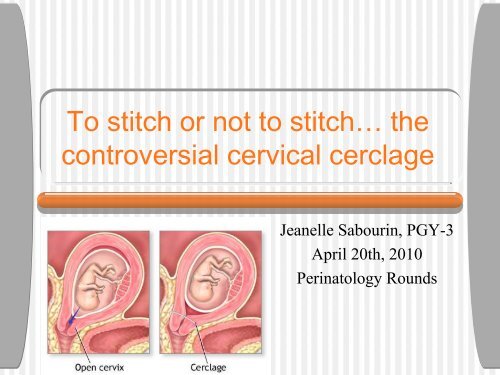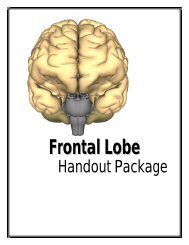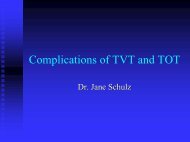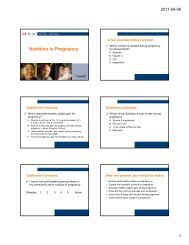The Controversial Cervical Cerclage - Onehealth.ca
The Controversial Cervical Cerclage - Onehealth.ca
The Controversial Cervical Cerclage - Onehealth.ca
Create successful ePaper yourself
Turn your PDF publications into a flip-book with our unique Google optimized e-Paper software.
To stitch or not to stitch… the<br />
controversial cervi<strong>ca</strong>l cerclage<br />
Jeanelle Sabourin, PGY-3<br />
April 20th, 2010<br />
Perinatology Rounds
Objectives<br />
• Summarize the methods and evidence for cervi<strong>ca</strong>l<br />
length measurement and describe its relationship to<br />
preterm birth<br />
• List the indi<strong>ca</strong>tions and perioperative considerations<br />
for cervi<strong>ca</strong>l cerclages<br />
• Describe the methods for vaginal and abdominal<br />
cerclages<br />
• Highlight the evidence (or lack of!) regarding cervi<strong>ca</strong>l<br />
cerclages by discussing various clini<strong>ca</strong>l scenerios
US measurement of<br />
<strong>Cervi<strong>ca</strong>l</strong> Length (CL)<br />
• TVU - gold standard<br />
• Highly reproducible (
Effacement<br />
• Starts at the internal cervi<strong>ca</strong>l os and<br />
proceeds <strong>ca</strong>udad over a period of weeks<br />
• Relationship between the lower uterine<br />
segment and the axis of the cervi<strong>ca</strong>l <strong>ca</strong>nal<br />
changes - Funneling<br />
• Trust Your Vaginal Ultrasound
Associated Findings<br />
• Funneling: opening of the internal os on US<br />
• Associated with a short cervix<br />
• NOT an independent predictor<br />
• Funneling in high risk women associated with increased likelihood of PTB<br />
• Funneling without shortening has no clini<strong>ca</strong>l signifi<strong>ca</strong>nce and does not<br />
increase risk<br />
• Usually related to lower uterine contraction<br />
• Debris or Sludge<br />
• Suggest subclini<strong>ca</strong>l infection<br />
• Independent risk factor for histologic chorioamnionitis and microbial<br />
invasion of the amniotic <strong>ca</strong>vity<br />
• Independent risk factor for PPROM and PTD<br />
• 71% of women with sludge delivered within 7d vs 16% without (Espinoza, 2005)
NEJM 334: 567 (1996)<br />
Sonographic Short Cervix<br />
• Inverse relationship<br />
between CL and risk of<br />
premature delivery<br />
• Risk is strongest with<br />
history of PTB 2 cm<br />
5%ile - 20mm<br />
10%ile - 25mm *<br />
50%ile - 35mm<br />
75%ile - 40mm<br />
90%ile - 50mm
Varying results depending on<br />
the population studied…<br />
• CL
Inverse relationship:<br />
CL and risk of PTB<br />
Obstet Gynecol 110: 311 (2007)
<strong>Cervi<strong>ca</strong>l</strong> Insufficiency<br />
• Term used to describe a presumed structural<br />
weakness of cervi<strong>ca</strong>l tissue<br />
• Present in women with a hx of painless cervi<strong>ca</strong>l dilation<br />
leading to birth in T2 without contractions or labor<br />
• Associated with sonographic evidence of a short cervix<br />
• Proposed <strong>ca</strong>uses<br />
• Surgi<strong>ca</strong>l trauma: conization, LEEP, overdilation<br />
• Obstetri<strong>ca</strong>l laceration<br />
• Congenital müllerian anomalies<br />
• Deficiencies in cervi<strong>ca</strong>l collagen and elastin<br />
• In utero DES exposure
Rationale behind cerclages<br />
• Improve the presumed structural deficit by mechani<strong>ca</strong>lly<br />
increasing the tensile strength of the cervix<br />
• HOWEVER…<br />
• Not universally successful in women with a hx of cervi<strong>ca</strong>l<br />
insufficiency or short cervix on US<br />
• Biochemi<strong>ca</strong>l agents (ie: progesterone) show some benefit<br />
• “It is likely a small percentage of T2 births are <strong>ca</strong>used only<br />
by congenital/structural weakness of the cervix and <strong>ca</strong>n be<br />
treated with a cerclage.” (UpToDate)<br />
• Most <strong>ca</strong>ses of T2 deliveries are probably <strong>ca</strong>used by other factors<br />
• decidual inflammation/infection<br />
• hemorrhage<br />
• uterine over-distension
PROPOSED indi<strong>ca</strong>tions for<br />
cervi<strong>ca</strong>l cerclage<br />
• Poor obstetri<strong>ca</strong>l history<br />
• elective cerclage at the end of T1 (12-14wks) to<br />
prevent ocurrence of early preterm birth<br />
• <strong>Cervi<strong>ca</strong>l</strong> shortening on ultrasound<br />
• urgent ultrasound indi<strong>ca</strong>ted cerclage<br />
• Advanced cervi<strong>ca</strong>l dilation on exam<br />
• emergent/rescue cerclage
Contraindi<strong>ca</strong>tions<br />
• Fetal anomaly incompatible with life<br />
• Intrauterine infection<br />
• Active bleeding<br />
• Active preterm labor<br />
• Premature rupture of membranes<br />
• Fetal demise<br />
• Prolapsing membranes - RELATIVE CI<br />
• Risk of iatrogenic rupture of membranes >50%<br />
• May try steep Trendelenburg, nitroglycerin, retrofilling maternal<br />
bladder, traction sutures on cervix, reducing with Foley bulb,<br />
amnioreduction
Compli<strong>ca</strong>tions<br />
• Contractions post-procedure<br />
• Common, not highly suggestive of increased risk of PTB<br />
• PROM<br />
• 1-18% with elective cerclage vs 3 to 65% with advanced dilation and<br />
prolapsing membranes<br />
• Chorioamnionitis<br />
• 1-6% elective cerclage vs 30-35% non-elective<br />
• Suture migration<br />
• 3-13%<br />
• Often late in gestation and of no clini<strong>ca</strong>l signifi<strong>ca</strong>nce<br />
• If early, studies suggest not to repeat procedure - worse outcomes<br />
• <strong>Cervi<strong>ca</strong>l</strong> dystocia in labor<br />
•
Timing<br />
• NOT WELL ESTABLISHED<br />
• ???<br />
• Considerations<br />
• Risk of mis<strong>ca</strong>rriage is high due to aneuploidy in early-mid T1<br />
• Waiting until end of T1 permits evaluation for some fetal<br />
anomalies, FTS or CVS<br />
• Delivery is likely to have a reasonably good outcome in T3<br />
• 24-28 wks- CONTROVERSIAL<br />
• High neonatal morbidity/mortality<br />
• Most avoid placement at this age given risk of iatrogenic ROM
Preoperative issues<br />
• Ultrasound examination<br />
• Confirm viability<br />
• R/o identifiable structural anomalies (ie: anencephaly)<br />
• First Trimester Screen<br />
• FHR pre-procedure<br />
• Consider evaluation and complete treatment of vaginal infections (STIs, BV)<br />
• R/o PPROM, PTL, Abruption, Subclini<strong>ca</strong>l infection<br />
• May want to observe patient 24 hrs prior to non-elective cerclage placement<br />
• Anesthesia: regional or general<br />
• CONTROVERSIAL: amniocentesis to evaluate for subclini<strong>ca</strong>l infections
Procedures<br />
• Transvaginal<br />
• McDonald<br />
• Shirodkar<br />
• Secondary analysis (n=277) using published data comparing the two<br />
methods in women with singleton pregnancy and short cervix on US<br />
showed no difference in PTB
Transvaginal - McDonald<br />
• McDonald cerclage<br />
• Pursestring suture<br />
• No dissection<br />
• Passes through stroma<br />
• Not placed as close to<br />
internal os as Shirodkar<br />
• Most common type of<br />
cerclage used
Transvaginal - Shirodkar<br />
• Shirodkar cerclage<br />
• Dissection of the bladder<br />
anteriorly and rectum posteriorly<br />
• Placed at the level of the internal<br />
os<br />
• Does not pass through cervi<strong>ca</strong>l<br />
stroma<br />
• Often necessitates OR to remove...<br />
• May keep in situ for next<br />
prengancy<br />
• C/S<br />
• ? Inflamation / subfertility /<br />
risk of erosion
Transabdominal cerclages<br />
• Recommended for women having<br />
cervi<strong>ca</strong>l insufficiency and 2+ failed<br />
transvaginal cerclages or in whom<br />
transvaginal cerclage not possible<br />
• Extreme shortening<br />
• S<strong>ca</strong>rring/Laceration of cervix<br />
• By laparotomy or laparoscopy<br />
• Suture at the cervicoisthmic<br />
junction<br />
• TIMING - no studies<br />
• Prior to conception<br />
• Less blood loss<br />
• No risk ROM<br />
• <strong>The</strong>oretic risk- subfertility<br />
• 11-14 wks GA<br />
• Delivery - elective CS 37-39wks<br />
• May/may not remove cerclage<br />
• Advantages<br />
• More proximal to internal os<br />
• Decreased risk of suture migration<br />
• Absence of foreign body in vagina<br />
• May leave in for subsequent pregnancies<br />
• Disadvantages<br />
• Potential need for 2 surgeries during pregnancy<br />
if cerclage must be removed<br />
• More morbidity vs vaginal
Transabdominal cerclages<br />
• Management of fetal demise<br />
• T1 - Dilation and Curettage safe<br />
• T2 - not clear.... ?removal of cerclage through colpotomy<br />
• Outcomes<br />
• No prospective studies...<br />
• Systematic review evaluating pregnancy in women with prior PTD<br />
despite transvaginal cerclage (n=157)<br />
• Lower likelihood of PTD
Postoperative issues<br />
• FHR post procedure<br />
• Bed rest…<br />
• Avoid intercourse (no evidence)<br />
• Tocolysis - no high quality evidence for this...<br />
• Indomethacin decreases post procedure-induced rise in PG level<br />
• BUT a retrospective cohort study found no evidence that use of<br />
indomethacin reduced the number of subsequent PTB<br />
• Ultrasound evaluation<br />
• Length >10-18mm between closed cervix proximal to cerclage is<br />
desirable (better predictor than overall CL)<br />
• FFN- should wait 4 wks... +ve result less reliable in this<br />
setting!<br />
• Remove cerclages in PTL or with infection, 37 wks with<br />
vaginal cerclage
<strong>The</strong> evidence for/against<br />
cervi<strong>ca</strong>l cerclages<br />
• CASES...<br />
• What would you do?<br />
• Disclaimer: I am not a<br />
cerclage expert! Not all<br />
trials are reviewed here...
CASES<br />
• G2P0@11 wks, 2 previous T2<br />
losses<br />
• Elective cerclage?<br />
• Early PV exams?<br />
• Serial TVU CL?<br />
• How often, when?<br />
• Threshold?<br />
• Routine <strong>ca</strong>re?<br />
• Progesterone<br />
• G2P1@10wks, previous PTB at<br />
26wks (no apparent <strong>ca</strong>use)<br />
• Elective cerclage?<br />
• Early PV exams?<br />
• Serial TVU CL?<br />
• Routine <strong>ca</strong>re?<br />
• Progesterone?
History indi<strong>ca</strong>ted cerclage-<br />
MRC/RCOG Multicentre RCT<br />
Br J Obstet Gynecol 100:516 (1993)
History indi<strong>ca</strong>ted cerclage<br />
• Only MRC/RCOG trial showed a statisti<strong>ca</strong>lly signifi<strong>ca</strong>nt difference in<br />
prevention PTB
Cochrane Review<br />
• 4 trials (n=2100) compared prophylactic cerclage and no<br />
cerclage (history indi<strong>ca</strong>ted… only one used TVU)<br />
• No overall reduction in pregnancy loss and PTD
CASES<br />
• G1P0 at 19wks with CL 25mm<br />
on routine US (no symptoms)<br />
• Urgent cerclage?<br />
• Serial TVU CL?<br />
• Threshold?<br />
• FFN?<br />
• Review gyne hx for additional<br />
risk factors?<br />
• And then what?<br />
• G2P1@22 wks with CL 20mm,<br />
current twin pregnancy,<br />
previous term delivery<br />
• Urgent cerclage?<br />
• FFN?
Short Cervix on US<br />
• Meta-analysis (Berghella et al, 2005)<br />
• 4 randomized trials (n=607) of pregnancies screened with cervi<strong>ca</strong>l US<br />
and randomly assigned to cerclage or no cerclage if cervix was short<br />
(
Obstet Gynecol 106:181 (2005)
Obstet Gynecol 106:181 (2005)
Short Cervix on US<br />
• Low risk women<br />
• Meta-analysis (Berghella et al, 2005)<br />
• No statisti<strong>ca</strong>l difference PTB
• G2P1@22wks, with<br />
previous PTB at 26wks<br />
(no <strong>ca</strong>use)<br />
• Serial TVU CL: Cervix<br />
24mm at 22 wks<br />
• Urgent cerclage?<br />
• Steroids at 24+ wks?<br />
• FFN?<br />
CASES
Am J Obstet Gynecol 201:375.e1 (2009)<br />
Short Cervix on US<br />
• Previous PTB<br />
• Meta-analysis (Berghella et al)<br />
• Less PTB
Am J Obstet Gynecol 201:375.e1 (2009)
Short Cervix on US<br />
• High risk women for cervi<strong>ca</strong>l insufficiency<br />
• “CIPRACT”, final analysis<br />
• Women with risk factors for cervi<strong>ca</strong>l insufficiency (previous<br />
PTB
CASES<br />
• Management of high risk<br />
women<br />
• Serial TVU for CL?<br />
• When, how often?<br />
• Threshold for cerclage?<br />
• Elective cerclage in T1?
History indi<strong>ca</strong>ted vs US<br />
indi<strong>ca</strong>ted cerclage<br />
• Similarly effective in prevention of PTB<br />
• Most studies show less procedures with<br />
ultrasound surveillance<br />
• Retrospective cohorts, matched <strong>ca</strong>se control studies<br />
• 36-60% require a cerclage (when CL
History vs ultrasound indi<strong>ca</strong>ted<br />
cervi<strong>ca</strong>l cerclage<br />
• “CIPRACT”, preliminary results<br />
• Women with previous PTB
Am J Perinatol 26:761 (2009)
History vs ultrasound indi<strong>ca</strong>ted<br />
cervi<strong>ca</strong>l cerclage<br />
• CIRCLE Trial<br />
• RCT of 248 women
• G2P1 @10 wks, cerclage in<br />
previous pregnancy (for??),<br />
went on to have term delivery<br />
• <strong>Cerclage</strong>?<br />
• Transvaginal or abdominal<br />
• Serial TVU for CL?<br />
CASES
Other specific circumstances<br />
• Future pregnancy and previous cerclage<br />
• Risk of recurrent cervi<strong>ca</strong>l insufficiency is 10-30%<br />
• 85% of women with previous PTB deliver at term!<br />
• 60% of women with hx of PTB or recurrent late mis<strong>ca</strong>rriages<br />
maintain CL >25mm and had low rates or recurrent PTB/loss<br />
without cerclage!<br />
• Most are offered repeat elective cerclage.. .BUT<br />
• If diagnosis of cervi<strong>ca</strong>l insufficiency is unsure, may follow with<br />
TVU-CL<br />
UpTo Date
• G2P0, 2 previous T2 losses,<br />
@22 wks and CL of 18mm and<br />
complete placenta previa<br />
• <strong>Cerclage</strong>?<br />
• Bed rest?<br />
CASES
Other specific circumstances<br />
• Placenta previa and cervi<strong>ca</strong>l insufficiency<br />
• Stable previa is not a CI to elective cerclage<br />
• Reduced risk of PTD
CASES<br />
• G3P0 @32 wks, PPROM, no signs<br />
of chorioamnionitis<br />
• Had elective cerclage at 11wks<br />
• Remove cerclage now?<br />
• Expectant management?<br />
• When would you remove the<br />
cerclage?<br />
• G3P0 @25 wks, PPROM, no signs<br />
of chorioamnionitis<br />
• Had elective cerclage at 11wks<br />
• Remove cerclage now?<br />
• Expectant management?<br />
• When would you remove the<br />
cerclage?
Other specific circumstances<br />
• PPROM<br />
• <strong>Cerclage</strong> removal controversial<br />
• ?earlier delivery<br />
• ?foreign body may increase risk of infections<br />
• Several observational studies - inconsistent results<br />
• GA at PROM is most important determinant of neonatal<br />
outcome<br />
• Based on limited data, UpToDate recommends<br />
removing cerclage if there is any evidence of<br />
chorioamnionitis or GA >32 weeks
CASES<br />
• G2P0, 2 previous T2 losses,<br />
@22 wks<br />
• 3cm dilated with bulging<br />
membranes<br />
• Emergency cerclage?<br />
• Bed rest?<br />
• TVU for CL? *<br />
• G1P0 @25 wks<br />
• 5 cm dilated with prolapsing<br />
membranes<br />
• Emergency cerclage?<br />
• Betamethasone?<br />
• Bed rest?<br />
• Amniocentesis?
Emergency cerclages<br />
• LIMITED EVIDENCE!!!<br />
• Better than bedrest according to cohort studies<br />
• Prospective randomized trial (n=23) to cerclage + indomethocin (13) vs<br />
bed rest alone (10) in women with membranes at/beyond dilated external<br />
os
• G4P0 @22 wks, historyindi<strong>ca</strong>ted<br />
cerclage at 11 wks<br />
now with TVU CL of 14mm<br />
• Reinforcing <strong>Cerclage</strong>?<br />
• Bed rest/ Expectant<br />
management<br />
CASES
Other specific circumstances<br />
• Reinforcing cerclage<br />
• Retrospective study of 24 women with history-indi<strong>ca</strong>ted cerclage<br />
who subsequently developed a short cervix
CASES<br />
• G4P1 @10 wks<br />
• 3 previous T2 losses including<br />
the last one at 23 wks despite<br />
McDonald cerclage at 12 wks<br />
• Elective cerclage?<br />
• Transvaginal<br />
• Shirodkar<br />
• McDonald<br />
• Abdominal<br />
• Laparotomy<br />
• Laparoscopy<br />
• Serial TVU for CL?<br />
• Off work, bed rest?
•REMEMBER<br />
• A short cervix <strong>ca</strong>n be from many <strong>ca</strong>uses...<br />
• <strong>Cervi<strong>ca</strong>l</strong> insufficiency is likely when<br />
• <strong>The</strong>re is a history of a cervi<strong>ca</strong>l abnormality or injury<br />
AND<br />
• A prior second trimester loss AND<br />
• A short cervix AND<br />
• No evidence of inflammation (membrane separation,<br />
edema, intrauterine debris) or hemorrhage
Review<br />
• Candidates for cerclage…<br />
• High risk women with singleton pregnancies...<br />
especially with CL 25mm<br />
• Multiple pregnancy and short cervix
References<br />
• UptoDate<br />
• <strong>Cervi<strong>ca</strong>l</strong> insufficiency<br />
• Transvaginal cervival cerclage<br />
• Transabdominal cervi<strong>ca</strong>l cerclage<br />
• Prediction of spontaneous preterm birth<br />
• Prediction of prematurity by transvaginal ultrasound<br />
assessment of the cervix<br />
• ACOG Practice Bulletin No. 48, “<strong>Cervi<strong>ca</strong>l</strong><br />
Insufficiency”, November 2003
















